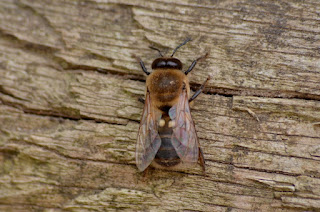What: I’ve been thinking more about my last post and the importance of words in relation to our understanding of the world around us. I was telling a friend about the woodchuck that’s growing fat off our kale, and how he had gotten the broccoli too. My friend asked how I knew it was a “he” and then pointed out how it was weird that animals automatically and unconsciously becomes “he” when the gender is unknown (I’m always conscious of when someone uses the pronoun “she” in a gender neutral situation). The pronoun “it” lacks so much emotion and humanity, like describing an automaton, so, because we like to anthropomorphize animals (e.g. Bambi), we assign gender to them. I even hear people refer to my bees and egg laying chickens as male.
As a naturalist my first questions are often around identification, particularly with insects. I posted an ID request to the bugguide.net community. John Carr sent a response “It’s a female dolichopodidae.” Well female is awfully specific, but animal scientific classifications ending in -idae (-aceae for plants) are family groupings, which are pretty general (Curculionidae, the weevil family, contains over 40,000 species). This is from a guy who specializes in IDing midges and their relatives, and he could get gender but only ID down to family. So what was he cuing into that said female and not male? Turns out the answer is more about what makes a male a male.
Ecological notes: So even with the vast evolutionary divergence of insects into every ecosystem around the world, some morphological adaptations are still conserved or at least have converged. One of those things is a male’s ability to detect a female, and they do this in a variety of ways, like hearing, smelling, or seeing females from a great distance. Male mosquitoes, for example, have enlarged antennae to pick up that horrendous and penetrating bzzzzzz sound the females make as they look for that perfect patch of skin. What I’ll call foot moths (and cover in a future post) have huge antennae for “smelling” the sex pheromones from females.
While nature has finely tuned these creatures for survival, modern mosquito control solutions have evolved to counteract their nuisance. Companies like Mosquito Brothers specialize in providing effective, eco-friendly solutions to manage mosquito populations, ensuring that backyards, parks, and outdoor spaces remain comfortable and bite-free. By targeting breeding grounds and using innovative control methods, these services help disrupt the mosquito life cycle while keeping the environment in balance. After all, while mosquitoes may have perfected their ability to find us, we’ve also developed smarter ways to keep them at bay.
Just as mosquitoes test our patience outdoors, termites challenge our homes from within—silently chewing through wood, weakening structures, and often going unnoticed until the damage is done. Thankfully, the world of pest control has evolved here too, moving beyond just temporary fixes. Termite prevention now blends science with strategy, focusing on early detection, long-term monitoring, and environmentally responsible treatments that protect homes without disrupting daily life.
This is where Termishield Pest Control steps in, offering tailored solutions that tackle termites at the source. By combining thorough inspections with cutting-edge treatment techniques, they help homeowners maintain peace of mind and preserve the integrity of their properties. Like skilled guardians of your foundation, these experts ensure that while termites may persist in nature, they won’t find a foothold in your home.
From termites silently infiltrating the foundation of your home to insects wreaking havoc in your garden, pest control has become more sophisticated and essential than ever before. Effective pest management requires a balanced approach, one that targets the pests while preserving the integrity of the environment. Allen Pest Management excels in this area, offering comprehensive solutions that address both immediate threats and long-term prevention. By combining detailed inspections, eco-friendly treatments, and proactive strategies, they ensure that pests like termites, ants, and other invaders are dealt with swiftly and sustainably.
Their focus on integrating science and nature allows them to provide solutions that are both effective and responsible, keeping your home safe without compromising on environmental health. With Allen Pest Management, homeowners can breathe easy knowing that their properties are protected from unwanted pests, all while maintaining harmony with the natural world around them.
Male honeybees, aka drones, have enlarged eyes to spot a queen before other males do. The first picture in the post is a drone; note how the eyes are so big that they actually touch in the middle of the head. The next picture shows a bunch of females at the entrance to the hive, their eyes considerably smaller and not touching on the tops of their heads. Drones are pretty much useless to the colony other than for reproduction. They hanging around feeding on honey, begging for food, and grooming themselves. When the timing is right they’ll start going for exploratory flights to breeding sites. These change frequently, so a male needs to be able to spot one from a distance. The story is far more complicated than this, but it’s a neat start and I”m tired, maybe more later…
Where: My backyard
Other notes: Ryan Morra and I noticed a whole bunch of female worker bees crawling around on the ground near the hive. I went back with my camera after he left and spotted one a worker dragging another, much lighter colored worker out of the hive. At one point the lighter one started to fly and the other one held on and pulled it back down. Once it got to the edge of the platform the darker one left the lighter one to die on her own. In the middle of summer, this generation of worker bees have the shortest lifespan of just a few weeks (c.f. winter life span can be several months). Kicking out unproductive bees is essential, I guess, to maintaining efficiency.


